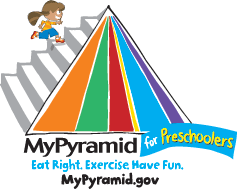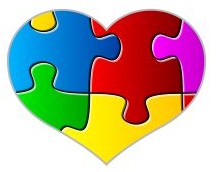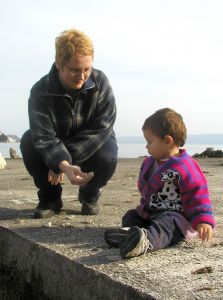By Emily Rempe, founder of Productive Parenting
We are all too aware of how modern technology is changing our lifestyles. Arguments could be made with much validity on each side to the merits and detriments of its steady infiltration into our lives. I am not writing to deny or defend the impacts of modern technology in our society and in our families. Rather, I am writing to declare with confidence one area that remains unsurpassed by modern technology – your child’s play.
Children are designed to explore and understand the world around them through their senses. Their primary field guides in this exploration is you: the parent. Parents understand the importance of this role and aspire to introduce their young children to the world around them in creative and engaging ways. However motivated parents may be, when it comes to specific ways of engaging with their children in meaningful play, I often hear a collectively shared experience of inadequacy. This is when it becomes easy to buy into modern technology in an attempt to provide us with a commercialized means to nurture our children.
Why Do We Feel Inadequate?
I would like to offer my thoughts on why the perceived sense of inadequacy exists and how it can be alleviated. A generation ago, our mothers’ educational opportunities were primarily limited to nursing and teaching. As these teachers became mothers, they naturally applied what they were doing in the classroom to their own children. The understanding of early childhood development easily translated into age appropriate ways of engaging with their own brood.
While it is wonderful that the opportunities available to women today are much broader, it has created a need for early childhood experts to share their expertise with parents who have become educated and skilled in other areas of study.
Components of Meaningful Play
When parents are equipped with the insights and ideas of early childhood experts to promote learning through the five senses, two key developments take place that cannot be usurped by modern technology:
- It promotes experiential learning through a child’s five senses which lays a fundamental understanding of the world around them.
- Sharing the learning experiences together promotes and deepens bonds between parent and child that will lay a strong foundation for their future relationship.
When we as parents become a vital part of this nurturing process through activities that promote bonding between parent and child, we are well on our way of fulfilling our role. Equipped with timeless activities that have been nurturing young minds for centuries, we do not need to feel inadequate in our approach.
Attachment-Promoting Toddler Games
Below are a few examples of play activities that engage the senses and strengthen the attachment bond between you and your toddler. These suggestions come from ProductiveParenting.com, which offers simple ways to bond with your newborn through five-year-old child.
Clapping Numbers
Target Age: Early 2 year old
What To Do: Children learn using the sense of hearing. Listening and following directions are important skills for your child. Introduce this fun activity by saying, “I will clap one time.” Clap. “I will clap two times.” Clap. Clap. Continue up to four times. Have your child try clapping one, two, three, and four times. Continue only if your child is still interested.
Phone Conversations
Target Age: Middle 2 year old
Materials You Will Need: Two toy phones or disconnected phonesWhat To Do: Your child has seen and heard you on the phone many times. Now may be the time to let your child have a conversation with you on the phone! Dial your home number. Say it out loud as you dial. Talk to your child. Give your child time to talk to you. Show your child how to dial the home number. Keep the phones on the toy shelf for playtime.
Letter to Myself
Target Age: Late 2 year old
Materials You Will Need: paper, envelope, stampWhat To Do: Children love to bring in the mail! Help your child understand how this works firsthand with today’s activity! Begin by having your child write a letter. (This usually means drawing.) Put your child’s letter in an envelope. Address the letter to your child. Let your child put a stamp on the envelope. Take your child to a mailbox and let your child put the letter in the mailbox. Let your child check the mail every day until the letter arrives. Children are so excited to receive mail, just like you do!
Past, Present, Future
Target Age: Early 3 year oldWhat To Do: Today’s activity will help develop your child’s concept of time. Discuss the concepts of past, present, and future with your child. Give your child a few examples of things that have happened in the past (last birthday, last vacation, etc.), and see if your child can come up with some, too. Now discuss today’s events as things that are happening in the present. Do the same for things that will or may happen in the future. Test your child’s understanding of the concept by giving your child an event and asking him/her to categorize it.
Coin Patterning
Target Age: Late 3 year old
Materials You Will Need: assortment of coinsWhat To Do: While waiting in a restaurant, use the coins you have in your pocket or wallet to practice patterning with your child. Start with simple patterns, like penny, nickel, penny, nickel and see if your child can continue the pattern. Try more complicated patterns with more than two coins or let your child come up with his/her own patterns.
 My son Jason, now a young adult, has been unschooled from the beginning – we were fortunate to have discovered John Holt’s books when Jason was two, and never looked back.
My son Jason, now a young adult, has been unschooled from the beginning – we were fortunate to have discovered John Holt’s books when Jason was two, and never looked back. Perhaps no activity can consume as much of an expectant couple’s time and energy as choosing a name for their baby. While other aspects of pregnancy and preparing for childbirth and parenting may interest one parent more than the other, both mom and dad are equally invested in the deliberations for just the right name.
Perhaps no activity can consume as much of an expectant couple’s time and energy as choosing a name for their baby. While other aspects of pregnancy and preparing for childbirth and parenting may interest one parent more than the other, both mom and dad are equally invested in the deliberations for just the right name. Five years ago, I had very firm ideas about childhood nutrition. “Balanced meals” was my mantra. I presented plates with foods of different colors (indicating different nutrients), and I sought out whole foods, natural foods, and organic foods. My firstborn stuck up his nose at much of it. Even the foods children are “supposed” to love – macaroni and cheese, pizza, and hot dogs – earned his disdain.
Five years ago, I had very firm ideas about childhood nutrition. “Balanced meals” was my mantra. I presented plates with foods of different colors (indicating different nutrients), and I sought out whole foods, natural foods, and organic foods. My firstborn stuck up his nose at much of it. Even the foods children are “supposed” to love – macaroni and cheese, pizza, and hot dogs – earned his disdain. Parenting during the teenage years is as trying on the young adult as it is on his parents. But if your child was adopted or if you’re fostering, the teenage years can be an especially tough time as your child tries to sort out his identity without knowing his birth parents or understanding the reasons why his birth parents are not a bigger part of his life.
Parenting during the teenage years is as trying on the young adult as it is on his parents. But if your child was adopted or if you’re fostering, the teenage years can be an especially tough time as your child tries to sort out his identity without knowing his birth parents or understanding the reasons why his birth parents are not a bigger part of his life. When I was younger, my mother would take my sister and I to browse through little shops in our hometown full of local artisan’s crafts. She never bought anything; she just liked to look. On one of the trips when I was about eight years old, I spied a replica of a U.S. quarter about the size of a saucer and I just had to have it. I didn’t have any money with me, and when I asked my mom if she could buy it for me, she said no. So, when no one was looking, I put it in my coat pocket.
When I was younger, my mother would take my sister and I to browse through little shops in our hometown full of local artisan’s crafts. She never bought anything; she just liked to look. On one of the trips when I was about eight years old, I spied a replica of a U.S. quarter about the size of a saucer and I just had to have it. I didn’t have any money with me, and when I asked my mom if she could buy it for me, she said no. So, when no one was looking, I put it in my coat pocket. Do you find yourself getting frustrated with your teen? So does every parent at some time. What about anger – has your relationship with your teen turned into a fight for control, and it seems that all your exchanges with your teen seem to be out of anger? For many parents, this is the sad reality of their relationship with their teenager.
Do you find yourself getting frustrated with your teen? So does every parent at some time. What about anger – has your relationship with your teen turned into a fight for control, and it seems that all your exchanges with your teen seem to be out of anger? For many parents, this is the sad reality of their relationship with their teenager. It is an understatement to say that step-families have many challenges to overcome. Step-families often are formed out of loss – demise of a partner, a broken marriage. If such events are recent, bringing about a change by getting married again might create a bigger challenge: Children can experience difficulty in adjusting to their new family, although it is no less a testing time for the children’s parents and their new partner.
It is an understatement to say that step-families have many challenges to overcome. Step-families often are formed out of loss – demise of a partner, a broken marriage. If such events are recent, bringing about a change by getting married again might create a bigger challenge: Children can experience difficulty in adjusting to their new family, although it is no less a testing time for the children’s parents and their new partner. Our children model our behavior. When surrounded by people who love them and respond to them sensitively and empathetically, they learn to respond this way to others. In my view, the API principle of Responding with Sensitivity best illustrates the concept of Attachment Parenting (AP). I may or may not adhere to all the principles of AP, but if emotional responsiveness does not permeate my parenting, then I question whether I can cultivate a strong bond with my children.
Our children model our behavior. When surrounded by people who love them and respond to them sensitively and empathetically, they learn to respond this way to others. In my view, the API principle of Responding with Sensitivity best illustrates the concept of Attachment Parenting (AP). I may or may not adhere to all the principles of AP, but if emotional responsiveness does not permeate my parenting, then I question whether I can cultivate a strong bond with my children. Many attachment parents say that the API Principle, Striving for Personal and Family Balance, is the cornerstone of Attachment Parenting (AP). We tend to be less emotionally responsive when we are struggling to achieve balance in our families, and this lack of responsiveness may impact the quality of attachment between us and our children. We may need help when our family life is out of balance, but the wide range of parenting advice can be confusing, even overwhelming.
Many attachment parents say that the API Principle, Striving for Personal and Family Balance, is the cornerstone of Attachment Parenting (AP). We tend to be less emotionally responsive when we are struggling to achieve balance in our families, and this lack of responsiveness may impact the quality of attachment between us and our children. We may need help when our family life is out of balance, but the wide range of parenting advice can be confusing, even overwhelming.